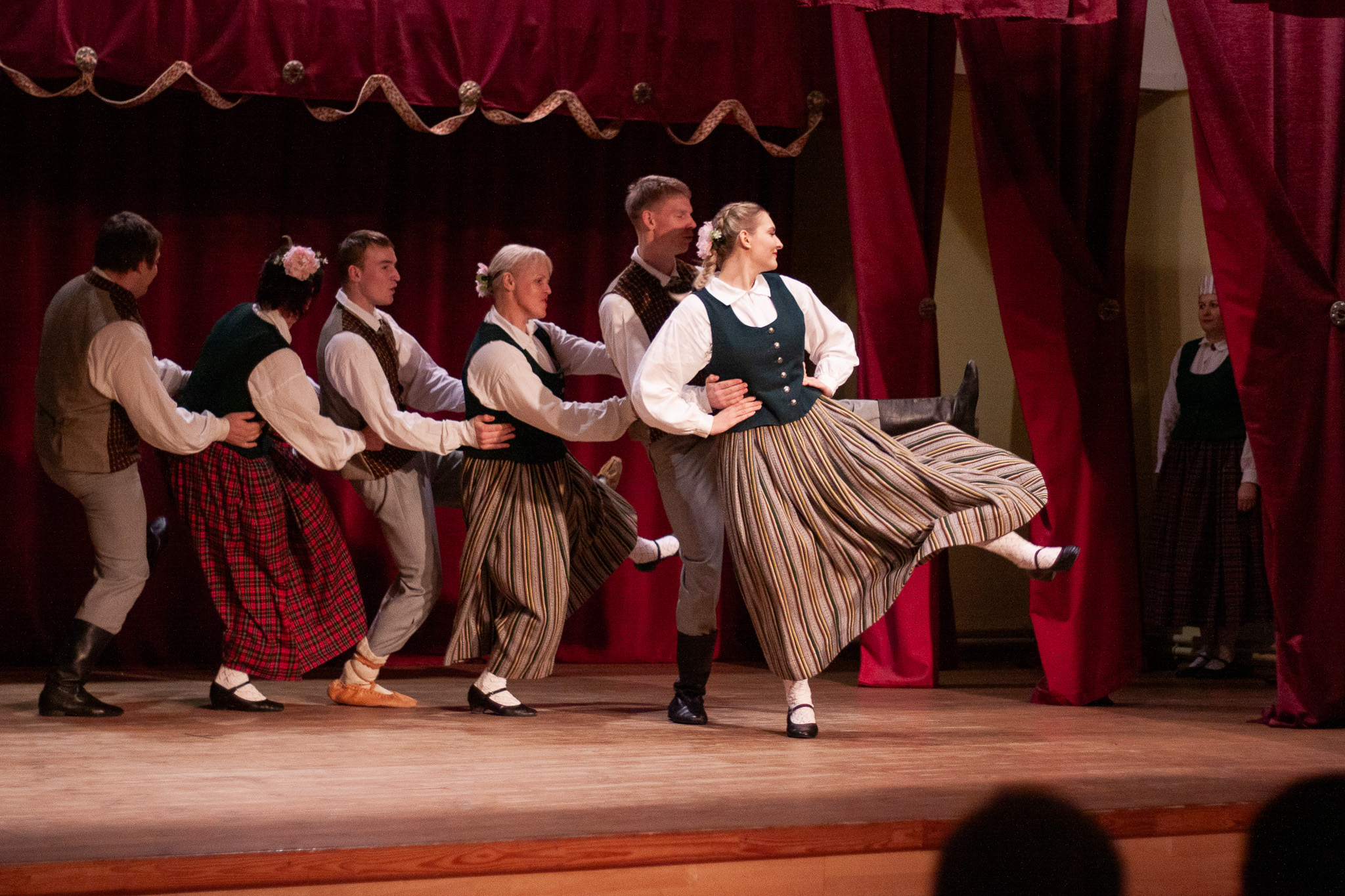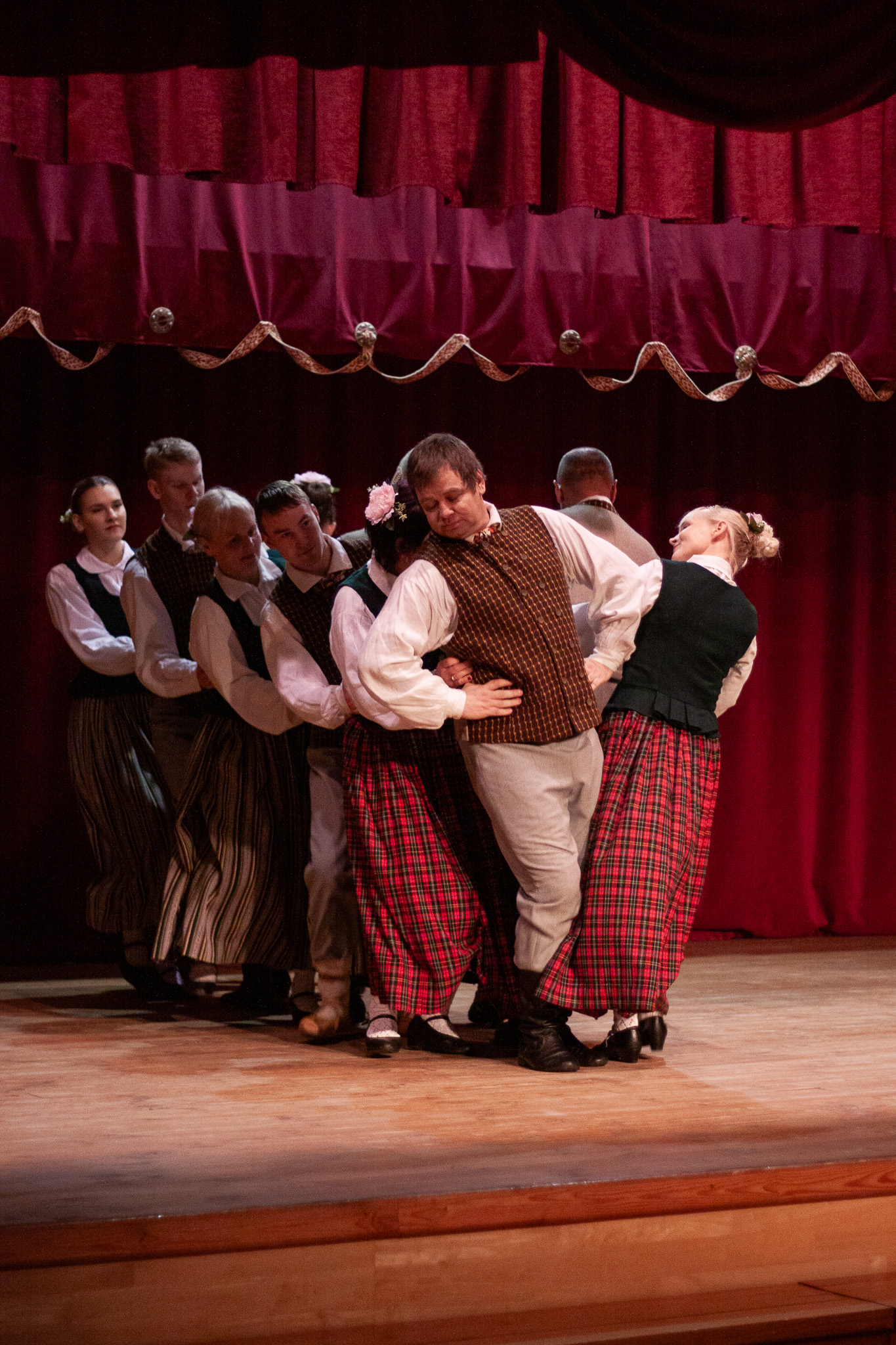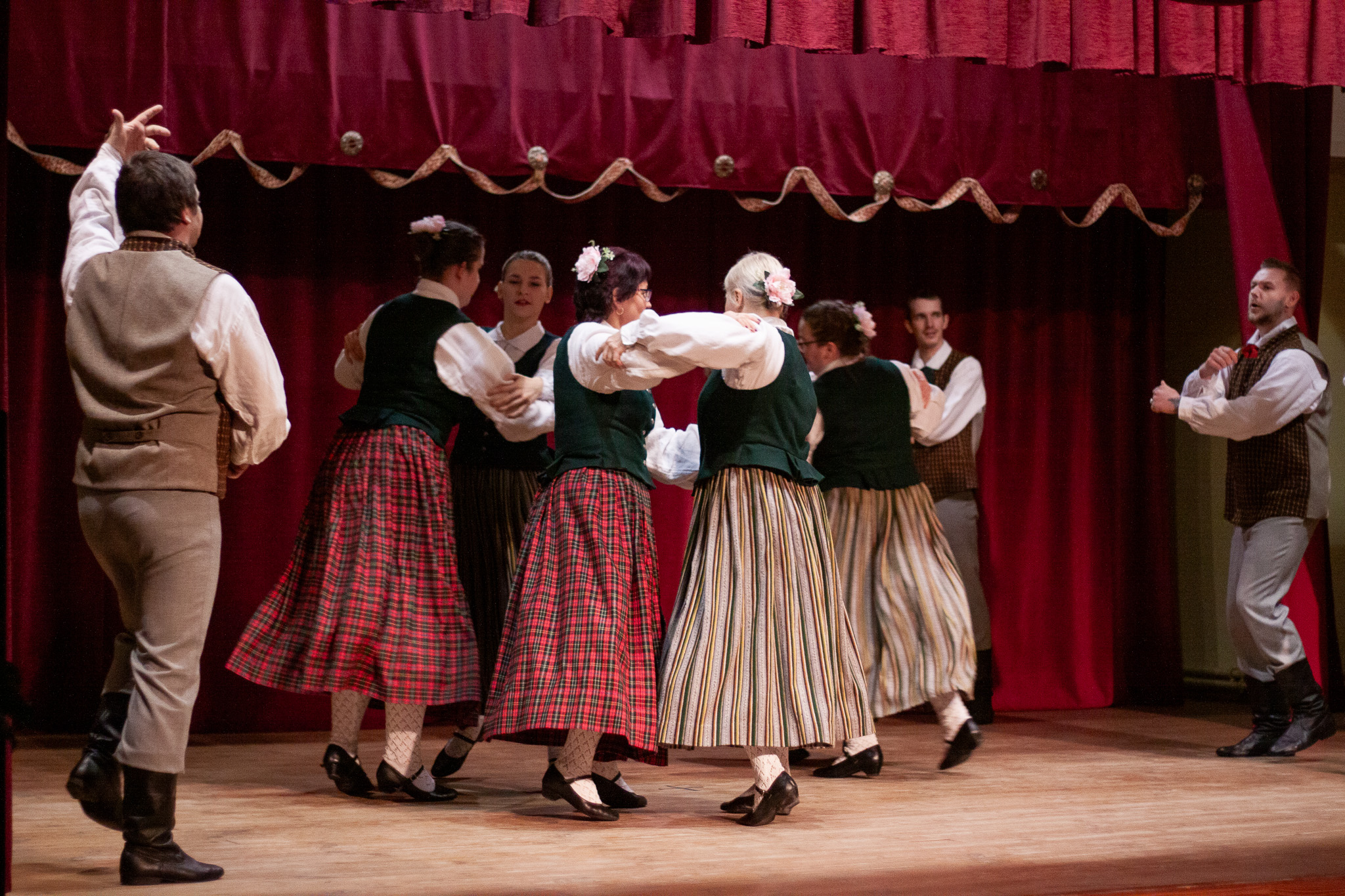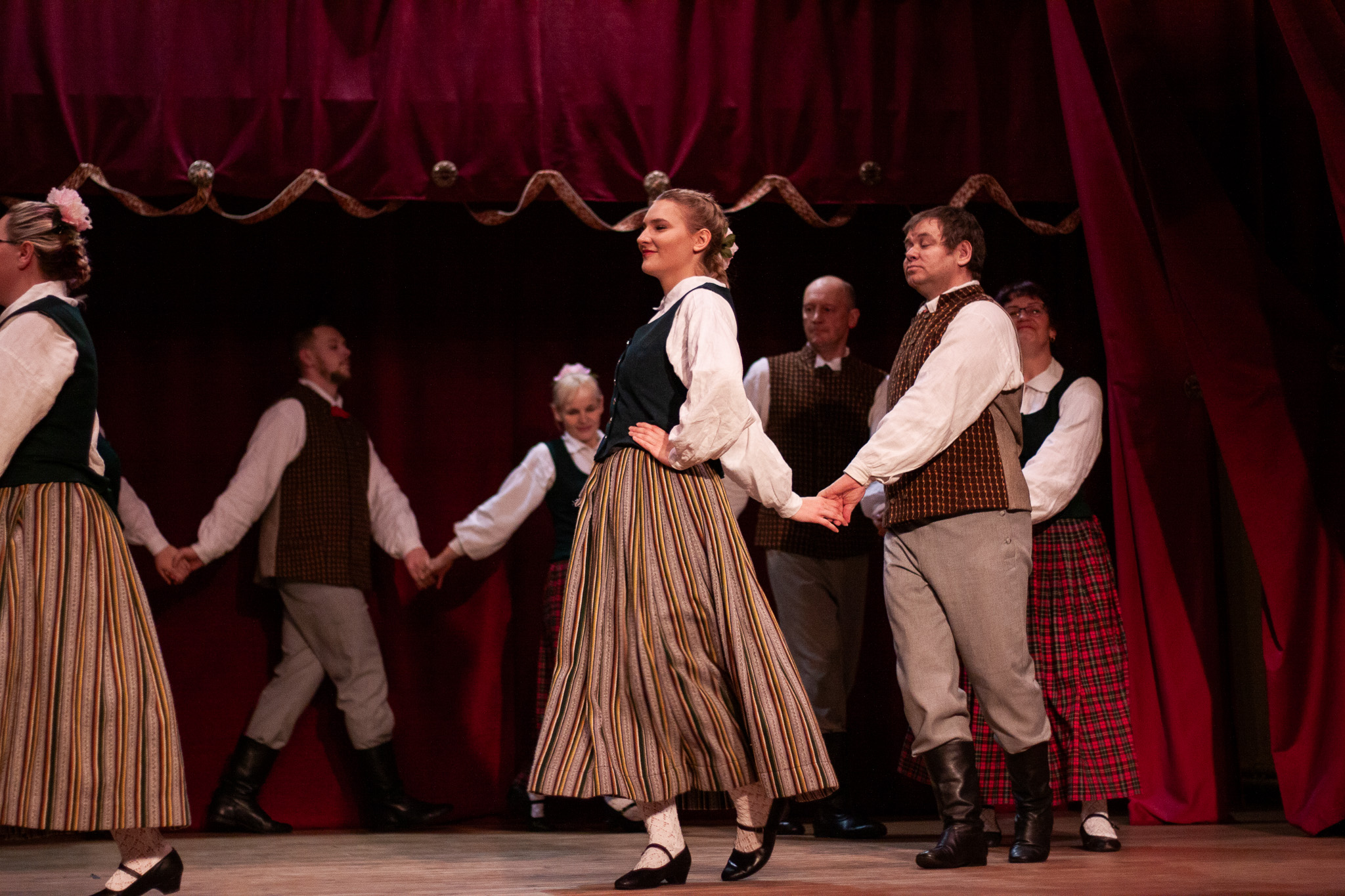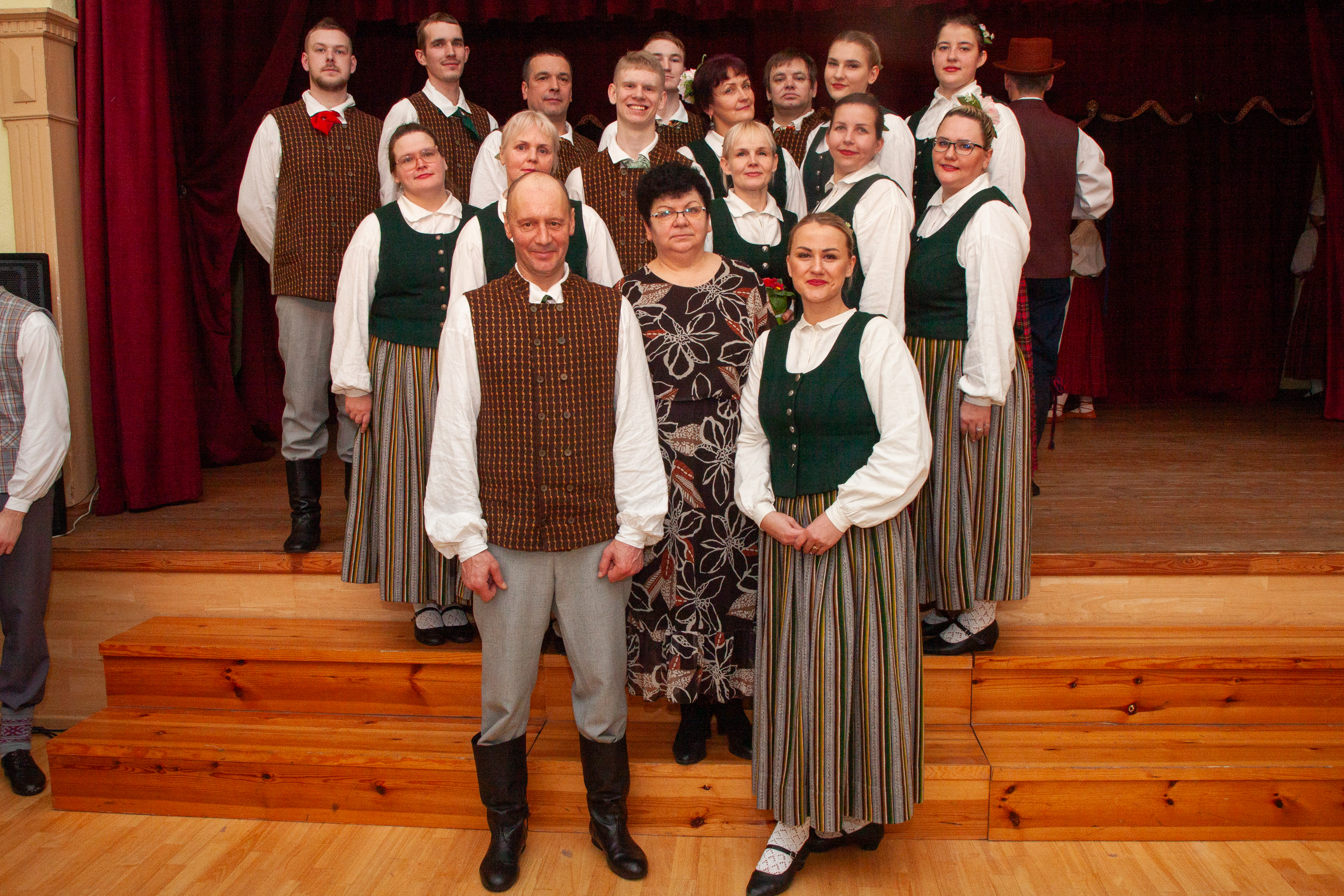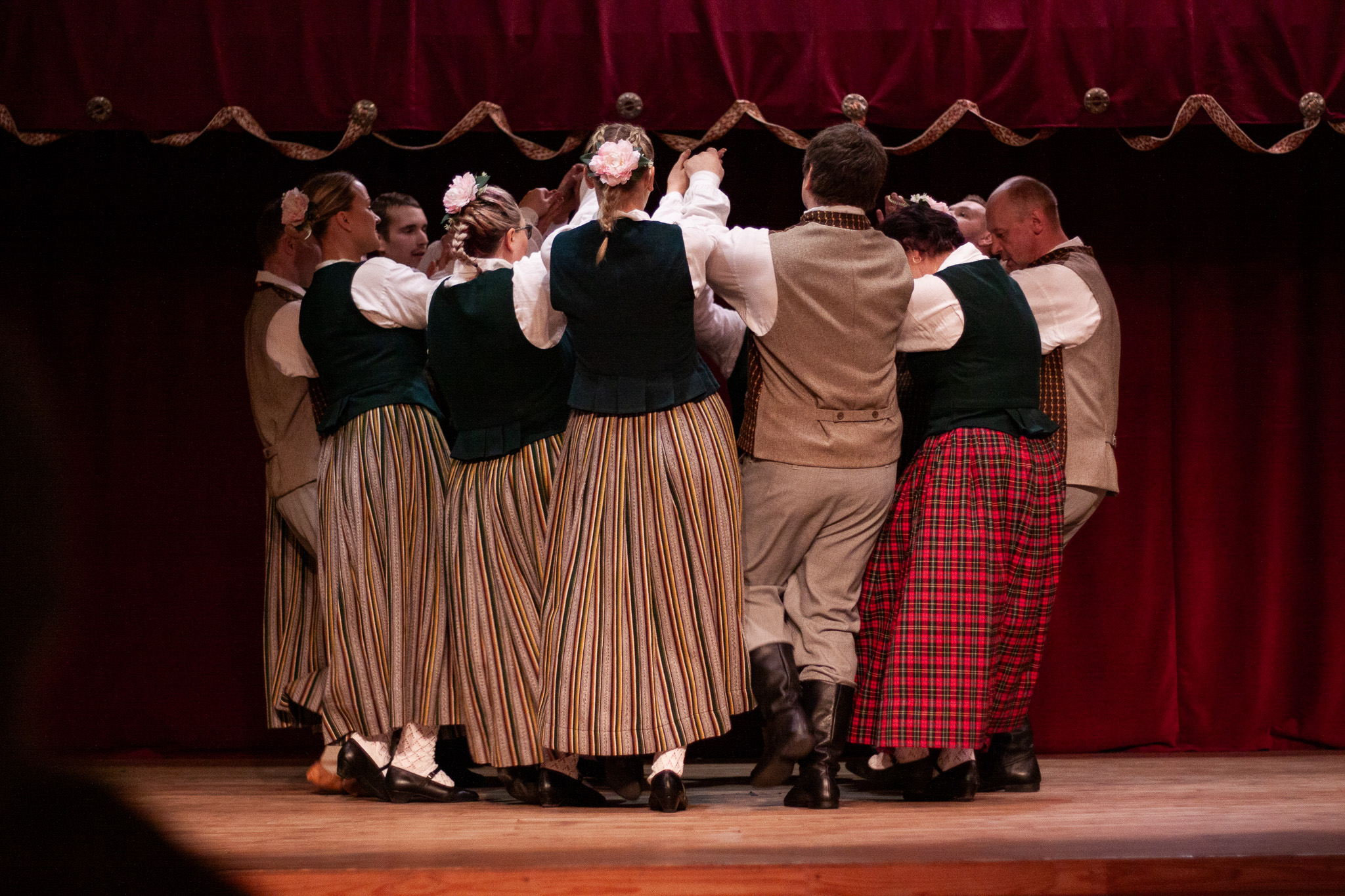Regaining a sense of belonging
Preserving Tradition Through Attire
Folk Costumes for "Lai" – Our Identity on Stage and in Heart
We are a middle-generation dance group that has come together and chosen to dance. We dance within our region because, at the moment, a newly formed dance group does not have a folk costume corresponding to the costume standard. Newly created folk costumes would allow us to participate in shows and promote Latvian cultural heritage and traditions.
Latvia
Local
Liepna
It addresses urban-rural linkages
It refers to other types of transformations (soft investment)
Yes
2024-08-23
No
No
No
As an individual
Specific Objectives
Ensure that all dancers in the collective have matching, high-quality folk costumes that align with traditional designs.
Strengthen cultural identity and artistic expression through authentic representation in performances.
Increase participation in national and international folk dance events, promoting Latvian heritage on a broader stage.
Support local artisans and sustainable craftsmanship by collaborating with traditional costume makers.
Foster community engagement and intergenerational knowledge transfer, encouraging younger generations to appreciate and continue folk traditions.
Achieved Outcomes
Preservation and promotion of Latvian folk traditions through performances and community involvement.
Stronger group identity and inclusion, ensuring that all members feel equally represented.
Collaboration with local artisans, fostering sustainability and craftsmanship.
Long-term impact on cultural heritage, as the costumes will serve not only the current but also future generations of dancers.
This project is not just about new costumes—it is about keeping the spirit of Latvian folk dance alive, strengthening cultural traditions, and ensuring that they continue to thrive in the modern world.
Ensure that all dancers in the collective have matching, high-quality folk costumes that align with traditional designs.
Strengthen cultural identity and artistic expression through authentic representation in performances.
Increase participation in national and international folk dance events, promoting Latvian heritage on a broader stage.
Support local artisans and sustainable craftsmanship by collaborating with traditional costume makers.
Foster community engagement and intergenerational knowledge transfer, encouraging younger generations to appreciate and continue folk traditions.
Achieved Outcomes
Preservation and promotion of Latvian folk traditions through performances and community involvement.
Stronger group identity and inclusion, ensuring that all members feel equally represented.
Collaboration with local artisans, fostering sustainability and craftsmanship.
Long-term impact on cultural heritage, as the costumes will serve not only the current but also future generations of dancers.
This project is not just about new costumes—it is about keeping the spirit of Latvian folk dance alive, strengthening cultural traditions, and ensuring that they continue to thrive in the modern world.
Culture
Unity
Folk dances
Tradition
Identity
Sustainability: We prioritize natural, locally sourced materials such as linen and wool for the folk costumes, ensuring minimal environmental impact while supporting local textile producers and artisans.
Aesthetics: The project revives and maintains the artistic and historical beauty of traditional Latvian folk costumes, ensuring authenticity and craftsmanship in every detail.
Inclusion: The project strengthens community identity by engaging local artisans, dancers, and cultural institutions in the process, fostering intergenerational knowledge exchange and cultural continuity.
Sustainability Objectives and Exemplary Approach
Use of Eco-Friendly Materials
The folk costumes are made from sustainable and biodegradable fabrics such as linen and wool, minimizing synthetic material use.
Dyes used in the production process are sourced from natural, non-toxic ingredients.
Support for Local Craftsmanship
By collaborating with local weavers, tailors, and embroiderers, the project boosts regional craftsmanship and traditional textile-making industries, ensuring the survival of these skills.
Long-Term Durability and Circularity
The costumes are designed for long-term use with high-quality craftsmanship, reducing waste and excessive production cycles.
Whenever possible, older costumes are restored and repurposed rather than discarded.
Community Engagement and Educational Value
The project involves workshops and cultural events where community members can learn about sustainable fashion, traditional craftsmanship, and folk heritage.
Schools and local organizations participate in the knowledge-sharing process, ensuring younger generations appreciate the value of sustainability in cultural traditions.
Scalability and Replicability
The model of sustainable folk costume production can serve as an example for other dance groups and cultural organizations across Europe, promoting best practices in cultural sustainability.
Aesthetics: The project revives and maintains the artistic and historical beauty of traditional Latvian folk costumes, ensuring authenticity and craftsmanship in every detail.
Inclusion: The project strengthens community identity by engaging local artisans, dancers, and cultural institutions in the process, fostering intergenerational knowledge exchange and cultural continuity.
Sustainability Objectives and Exemplary Approach
Use of Eco-Friendly Materials
The folk costumes are made from sustainable and biodegradable fabrics such as linen and wool, minimizing synthetic material use.
Dyes used in the production process are sourced from natural, non-toxic ingredients.
Support for Local Craftsmanship
By collaborating with local weavers, tailors, and embroiderers, the project boosts regional craftsmanship and traditional textile-making industries, ensuring the survival of these skills.
Long-Term Durability and Circularity
The costumes are designed for long-term use with high-quality craftsmanship, reducing waste and excessive production cycles.
Whenever possible, older costumes are restored and repurposed rather than discarded.
Community Engagement and Educational Value
The project involves workshops and cultural events where community members can learn about sustainable fashion, traditional craftsmanship, and folk heritage.
Schools and local organizations participate in the knowledge-sharing process, ensuring younger generations appreciate the value of sustainability in cultural traditions.
Scalability and Replicability
The model of sustainable folk costume production can serve as an example for other dance groups and cultural organizations across Europe, promoting best practices in cultural sustainability.
Our project is dedicated to the preservation and revitalization of traditional Latvian folk costumes, ensuring that aesthetics, craftsmanship, and cultural significance are upheld to the highest standards. Through careful attention to design and historical accuracy, we aim to create a visually captivating, immersive, and meaningful experience for the community.
The costumes are meticulously crafted based on historical sources, museum archives, and expert consultations, ensuring authentic patterns, colors, and embroidery techniques that reflect Malupe's regional identity. Each piece is not only functional but also a work of art, maintaining the high visual standards of traditional Latvian attire. Skilled artisans and designers ensure that every detail, from woven fabrics to silver accessories, preserves the cultural richness of the costumes.
Wearing these costumes fosters a deep sense of belonging, pride, and identity for the dancers and the wider community. The project revitalizes intangible heritage, ensuring that younger generations experience Latvia’s cultural beauty firsthand rather than only through history books.The visual impact of well-crafted folk attire enhances the artistic expression of dance performances, making them more engaging for audiences.
Community Involvement & Cultural Continuity Local craftspeople, historians, and cultural organizations collaborate to ensure historical accuracy and artistic integrity. Educational workshops allow younger generations to learn about folk costume design, traditional weaving, and embroidery techniques, fostering appreciation for cultural heritage. The initiative strengthens cultural tourism and local craftsmanship, positioning Liepna as a regional center for traditional arts and design.
The costumes are meticulously crafted based on historical sources, museum archives, and expert consultations, ensuring authentic patterns, colors, and embroidery techniques that reflect Malupe's regional identity. Each piece is not only functional but also a work of art, maintaining the high visual standards of traditional Latvian attire. Skilled artisans and designers ensure that every detail, from woven fabrics to silver accessories, preserves the cultural richness of the costumes.
Wearing these costumes fosters a deep sense of belonging, pride, and identity for the dancers and the wider community. The project revitalizes intangible heritage, ensuring that younger generations experience Latvia’s cultural beauty firsthand rather than only through history books.The visual impact of well-crafted folk attire enhances the artistic expression of dance performances, making them more engaging for audiences.
Community Involvement & Cultural Continuity Local craftspeople, historians, and cultural organizations collaborate to ensure historical accuracy and artistic integrity. Educational workshops allow younger generations to learn about folk costume design, traditional weaving, and embroidery techniques, fostering appreciation for cultural heritage. The initiative strengthens cultural tourism and local craftsmanship, positioning Liepna as a regional center for traditional arts and design.
The project ensures that financial constraints do not prevent participation in folk dance and cultural traditions. By securing funding for costumes, we eliminate the burden on individual dancers, making traditional attire accessible to all, regardless of economic background. Handmade folk costumes are often expensive due to the craftsmanship involved. Our approach focuses on community-driven production, local artisan partnerships, and responsible budgeting to make high-quality costumes more affordable and sustainable.
The costumes are created with comfort, adaptability, and inclusivity in mind, ensuring they are suitable for dancers of different ages, body types.
Traditional costume-making workshops are open to all community members, allowing individuals to engage in the process and connect with local heritage. By involving both young and elderly generations in discussions about design and historical authenticity, we encourage intergenerational knowledge exchange and ensure that diverse voices shape the outcome.
The project promotes social inclusion by engaging local artisans, cultural experts, schools, and organizations, ensuring broad participation in the preservation of traditional crafts. It fosters a shared cultural identity across generations, strengthening ties between rural communities and the broader national and European cultural landscape. Through folk dance performances, the costumes provide a platform for cultural storytelling, allowing diverse audiences to appreciate and connect with Latvian traditions.
The initiative encourages a cooperative approach—local designers, weavers, and artisans work together with cultural institutions and dance groups to create a self-sustaining model for costume production. The project serves as a scalable and replicable model for other rural communities looking to preserve their folk heritage in an inclusive and participatory way.
The costumes are created with comfort, adaptability, and inclusivity in mind, ensuring they are suitable for dancers of different ages, body types.
Traditional costume-making workshops are open to all community members, allowing individuals to engage in the process and connect with local heritage. By involving both young and elderly generations in discussions about design and historical authenticity, we encourage intergenerational knowledge exchange and ensure that diverse voices shape the outcome.
The project promotes social inclusion by engaging local artisans, cultural experts, schools, and organizations, ensuring broad participation in the preservation of traditional crafts. It fosters a shared cultural identity across generations, strengthening ties between rural communities and the broader national and European cultural landscape. Through folk dance performances, the costumes provide a platform for cultural storytelling, allowing diverse audiences to appreciate and connect with Latvian traditions.
The initiative encourages a cooperative approach—local designers, weavers, and artisans work together with cultural institutions and dance groups to create a self-sustaining model for costume production. The project serves as a scalable and replicable model for other rural communities looking to preserve their folk heritage in an inclusive and participatory way.
The dance collective is a group of local residents who perform together in daily concerts for Liepnas residents and guests. Thanks to the local amateur groups, the immigrants are also given the opportunity to integrate, as Liepnas has a refugee shelter whose residents attend concerts and enjoy the local culture, as a result of which they are introduced to our traditions.
This project will bring together people from different backgrounds with the common goal of Latvian folk traditions, as not only dancers but also craftsmen and people from the surrounding area will be involved in the projects.
This project will bring together people from different backgrounds with the common goal of Latvian folk traditions, as not only dancers but also craftsmen and people from the surrounding area will be involved in the projects.
The project will involve local and Latvia-wide participation, as it will bring together different craftspeople to help realize the idea of new folk costumes for the collective. Local craftspeople, designers, and dancers of the collective have done significant work on the development and adaptation of the folk costumes, ensuring authenticity and quality. Cultural organizations and local leaders helped to build cooperation between different interest groups, ensuring community support and involvement in the project. Regional craft associations and professional networks contributed to the selection of materials and quality monitoring of production, promoting authentic, sustainable solutions. National cultural institutions were involved in the project's consultation, ensuring the preservation of traditional elements and suggesting how to incorporate them in a contemporary context. International experts and European cultural organizations were involved in the project, providing additional resources, knowledge, and support to apply best practices in sustainable design and heritage conservation. By acquiring the new folk costumes, our collective will be able to go further by taking part in shows and now, in three years, in one of the biggest Latvian festivals, the Nationwide Latvian Song and Dance Festival. All Latvians unite and move to the same rhythm, creating a sense of community for the whole nation.
Weaving, embroidery, and textile arts are central to the project, ensuring the costumes remain true to their cultural roots. Local artisans who specialize in these crafts work with modern designers to create authentic patterns, fabrics, and embroidery, which are key to the visual and cultural identity of the folk costumes.
Experts in cultural heritage and ethnography played a crucial role in ensuring that the costumes adhere to the historical and cultural authenticity of Liepna’s folk traditions. They provided research and documentation about traditional folk attire, contributing insights into materials, design, and symbolism that were integral to the project.
A focus on sustainable design was integrated into the project by selecting natural, locally sourced materials and employing eco-friendly production methods. Sustainability experts helped assess the environmental impact of the materials used and ensured that the
Experts in cultural heritage and ethnography played a crucial role in ensuring that the costumes adhere to the historical and cultural authenticity of Liepna’s folk traditions. They provided research and documentation about traditional folk attire, contributing insights into materials, design, and symbolism that were integral to the project.
A focus on sustainable design was integrated into the project by selecting natural, locally sourced materials and employing eco-friendly production methods. Sustainability experts helped assess the environmental impact of the materials used and ensured that the
Integration of Sustainable Practices in Traditional Craftsmanship
Unlike conventional approaches that often rely on mass-produced fabrics and modern synthetic materials, our project emphasizes the use of natural, locally sourced materials—such as linen, and wool, that are deeply rooted in Latvian folk traditions.
The eco-friendly production methods employed reduce the environmental footprint, making the project a model for sustainable cultural heritage preservation. This commitment to sustainability is often overlooked in mainstream costume production, where the focus tends to be on speed and cost-efficiency over environmental impact.
By involving community members in creating the costumes, the project fosters a deep sense of ownership and cultural pride, making it more meaningful and connected to the people it represents.
Cross-Disciplinary Collaboration
Our project is marked by its transdisciplinary approach, bringing together not only cultural experts and textile artisans but also performing artists, and sustainability specialists. In contrast to mainstream practices, which often work within a single discipline, this collaborative approach ensures that the costumes are both culturally accurate and adaptable to the specific needs of dancers and performers.
The project also integrates modern design techniques with traditional craftsmanship, creating a dynamic blend of the old and the new. This ensures that the folk costumes are not only visually authentic but also meet the practical demands of performance.
By creating demand for traditional crafts, the project helps preserve and revitalize these skills in the local economy, creating sustainable livelihoods for artisans. The approach fosters a local cultural ecosystem, where each aspect—from design to production—contributes to economic resilience and community empowerment.
Unlike conventional approaches that often rely on mass-produced fabrics and modern synthetic materials, our project emphasizes the use of natural, locally sourced materials—such as linen, and wool, that are deeply rooted in Latvian folk traditions.
The eco-friendly production methods employed reduce the environmental footprint, making the project a model for sustainable cultural heritage preservation. This commitment to sustainability is often overlooked in mainstream costume production, where the focus tends to be on speed and cost-efficiency over environmental impact.
By involving community members in creating the costumes, the project fosters a deep sense of ownership and cultural pride, making it more meaningful and connected to the people it represents.
Cross-Disciplinary Collaboration
Our project is marked by its transdisciplinary approach, bringing together not only cultural experts and textile artisans but also performing artists, and sustainability specialists. In contrast to mainstream practices, which often work within a single discipline, this collaborative approach ensures that the costumes are both culturally accurate and adaptable to the specific needs of dancers and performers.
The project also integrates modern design techniques with traditional craftsmanship, creating a dynamic blend of the old and the new. This ensures that the folk costumes are not only visually authentic but also meet the practical demands of performance.
By creating demand for traditional crafts, the project helps preserve and revitalize these skills in the local economy, creating sustainable livelihoods for artisans. The approach fosters a local cultural ecosystem, where each aspect—from design to production—contributes to economic resilience and community empowerment.
Instead of relying on external suppliers or mass-market costume manufacturers, the project is designed to support local economies, particularly through partnerships with regional artisans and small businesses. This model contrasts with mainstream costume-making practices, which often prioritize cheap, outsourced labor and materials.
By creating demand for traditional crafts, the project helps preserve and revitalize these skills in the local economy, creating sustainable livelihoods for artisans. The approach fosters a local cultural ecosystem, where each aspect—from design to production—contributes to economic resilience and community empowerment.
By creating demand for traditional crafts, the project helps preserve and revitalize these skills in the local economy, creating sustainable livelihoods for artisans. The approach fosters a local cultural ecosystem, where each aspect—from design to production—contributes to economic resilience and community empowerment.
Our folk costume project has a strong potential for replication and transferability to other communities, regions, and cultural contexts. The methodology, processes, and key learnings can be adapted to different settings while maintaining a focus on cultural heritage preservation, sustainability, and community engagement. Below are the main transferable aspects:
Methodology and Community-Driven Approach
The project follows a participatory model, involving local artisans, cultural experts, and community members in the design and production process.
The approach fosters a sense of ownership among participants, ensuring long-term engagement and sustainability.
How it can be replicated:
This model can be applied in other communities that wish to preserve and revitalize their own traditional attire or handicrafts.
It can also be used in other cultural fields (e.g., traditional music, textile arts, or regional crafts) to ensure heritage continuity through local engagement.
The workshop-based format is scalable, meaning it can be adapted for schools, cultural centers, and community groups worldwide.
Methodology and Community-Driven Approach
The project follows a participatory model, involving local artisans, cultural experts, and community members in the design and production process.
The approach fosters a sense of ownership among participants, ensuring long-term engagement and sustainability.
How it can be replicated:
This model can be applied in other communities that wish to preserve and revitalize their own traditional attire or handicrafts.
It can also be used in other cultural fields (e.g., traditional music, textile arts, or regional crafts) to ensure heritage continuity through local engagement.
The workshop-based format is scalable, meaning it can be adapted for schools, cultural centers, and community groups worldwide.
Our folk costume project tackles several global challenges by implementing local, community-driven solutions. The project serves as a model for cultural heritage preservation, sustainability, and social inclusion, addressing key issues that are relevant on a worldwide scale.
Our project is continuous and long-term, as it is based on our folk dance group, which regularly comes together to learn new dances and prepare for performances and showcases. This is not a commercial project with income or stable funding—our activities are primarily supported by the local municipality, which provides rehearsal space and a dance instructor.
Currently, we are using folk costumes that remain from a previous dance group that was disbanded. However, these costumes are not sufficient for all members. New dancers receive adjusted costumes from the existing collection, which are altered and re-sewn to fit, but this does not create a unified and complete visual identity. To maintain the authenticity of our performances and the visual cohesion of the group, we have started investing our own personal resources into acquiring new folk costumes.
So far, we have taken the first steps—purchasing new traditional socks, designing a unique shirt as a recognizable symbol of our group, and creating headpieces. However, to fully equip all dancers with matching, high-quality folk costumes, additional funding is required.
Securing this support would allow our middle-generation folk dance group not only to continue dancing but also to reach greater goals, such as participating in dance showcases and the largest cultural events in Latvia, including the Latvian Song and Dance Festival. This would enable us to strengthen Latvian cultural traditions, preserve and pass them on to future generations, and unite in dance, standing shoulder to shoulder on both a national and international scale.
Currently, we are using folk costumes that remain from a previous dance group that was disbanded. However, these costumes are not sufficient for all members. New dancers receive adjusted costumes from the existing collection, which are altered and re-sewn to fit, but this does not create a unified and complete visual identity. To maintain the authenticity of our performances and the visual cohesion of the group, we have started investing our own personal resources into acquiring new folk costumes.
So far, we have taken the first steps—purchasing new traditional socks, designing a unique shirt as a recognizable symbol of our group, and creating headpieces. However, to fully equip all dancers with matching, high-quality folk costumes, additional funding is required.
Securing this support would allow our middle-generation folk dance group not only to continue dancing but also to reach greater goals, such as participating in dance showcases and the largest cultural events in Latvia, including the Latvian Song and Dance Festival. This would enable us to strengthen Latvian cultural traditions, preserve and pass them on to future generations, and unite in dance, standing shoulder to shoulder on both a national and international scale.

